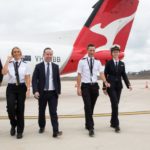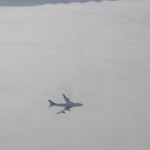Qantas announced a profit before tax (PBT) of $523 million for the half-year ended 31 December 2006, an 8.3 per cent increase on the prior comparative half-year to 31 December 2005.
SYDNEY – Net profit after tax increased only 1.7 per cent to $359 million as a result of a favourable tax charge in the prior corresponding half.
The Chairman of Qantas, Ms Margaret Jackson, said that in December 2006, under the terms of the Airline Partners Australia (APA) takeover offer for Qantas, it was stated that the interim dividend that would otherwise have been payable in April 2007 would not be available. It was further stated that the Board would evaluate whether a fully franked Special Dividend could be paid during the bid period and, if this were possible, the offer consideration would be reduced by the dividend amount.
“We have established that a fully franked dividend can be paid and, accordingly, the Directors have today declared a fully franked Special Dividend of 15 cents per share, payable whether the APA offer succeeds or not. This Special Dividend will fully utilise all Qantas available franking credits,” Ms Jackson said.
The Special Dividend will be paid to all Qantas shareholders who are recorded on the register at 5.00 pm (Sydney time) on 19 February 2007. Payment will be made on the earlier of 19 March 2007 and 10 business days after the APA offer is unconditional.
Ms Jackson said that in accordance with the APA offer terms, if the APA offer succeeded, Qantas shareholders would receive a total of $5.60, comprising the fully franked Special Dividend of 15 cents per share and the balance of the $5.60 offer price by way of cash payment from APA.
She said Qantas had also decided to suspend the Dividend Reinvestment Plan (DRP), a decision that had been contemplated prior to the takeover offer from APA. “This move is in line with the continued strength of the company’s balance sheet.” Ms Jackson said Qantas Directors believed the APA offer was the best opportunity for shareholders to realise significant value for their investment in Qantas.
She said the half-year result reflected buoyant consumer demand and efficiency improvements throughout the airline over the past three-and-a-half years. “Like other Australian companies, we have benefited from the continued strength in the Australian economy,” Ms Jackson said.
The Chief Executive Officer of Qantas, Mr Geoff Dixon, said crude oil prices had remained volatile during the six months — peaking at US$77 a barrel in July 2006.
[GADS_NEWS]“This has resulted in a total fuel bill $388 million higher than the comparative half year, after hedging. Mr Dixon said the volatility in price remained, with prices only a few weeks ago reaching US$50 a barrel, before moving up to the current price of around US$60.
“On current forecasts, we expect our full year fuel costs to be around $3.5 billion, over $660 million higher than the prior full year. “At these levels it is imperative we continue to seek efficiencies across all sections of our business.” Mr Dixon said Qantas’ Sustainable Future Program had achieved benefits of $319 million during the half-year.
“Business transformation under the Program enabled an underlying improvement in unit costs of 0.9 per cent. “We need to accelerate this unit cost reduction in the second half of the year if we are to achieve our target of $750 million.” Mr Dixon said other contributing factors to the half-year result were:
capacity growth of 3.7 per cent, particularly within the leisure market segments as Jetstar consolidated its position domestically following delivery of its A320 fleet in the prior year and commenced long haul international operations in November 2006;
a four-fold improvement in Jetstar’s profit for the half year from $10 million to $51 million (excluding start-up costs for Jetstar international’s operations);
an improvement in yield of 7.2 per cent (including the favourable impact of foreign exchange rate movements) and a 2.8 percentage point improvement in seat factor to 80.3 per cent, principally in Qantas Airlines where there had been an improvement in international operations;
cashflow from operations of over $1.0 billion which, after capital investments and other financing costs, saw the airline’s cash position improve by $151 million to over $3.0 billion.
Mr Dixon said Qantas needed to continue to adjust its business to meet ongoing intense international competition, potential new costs from changed environmental regulations, and an expected new low cost airline in the Australian domestic market.
“However, despite these challenges we have and will continue to expand and invest in existing and growing markets. “To this end, Jetstar International operations will expand to six A330-200 aircraft and Qantas will acquire four A330-200s over the next two years.
“Also, in late 2008 the Qantas Group will commence the introduction of the world’s newest aircraft, the Airbus A380 and the Boeing 787.”
He said Qantas had:
increased trans-continental capacity with the addition of wide body aircraft to these routes; and
increased Qantaslink capacity by over 20 per cent as it expanded regional flying with new Q400 aircraft;
successfully launched Jetstar international operations in November 2006, which had added six new destinations to the Qantas Group network and created 500 new jobs;
opened a new QantasLink pilot and cabin crew base in Canberra in September 2006, creating 30 jobs;
announced increased services to San Francisco from March 2007;
increased trans-continental capacity with the addition of wide body aircraft to these
routes; and
launched a range of product enhancements, including online check-in, with refreshed international menus and amenities on board from next month and state-of-the-art international First lounges opening in Melbourne and Sydney
Mr Dixon said the Qantas Group intended to build on its track record of growth and service excellence.
“I would like to take this opportunity to thank our staff for their unwavering professionalism during a period of difficult operating conditions and — more recently — relentless public speculation about the future of Qantas.”
Outlook
We believe that the full year result will be around 30 to 40 per cent higher than last year’s result subject to fuel costs not increasing significantly, demand continuing to grow and cost reductions not achieved in the first half being realised in the second half.
Group Revenue
Total revenue for the half-year was $7.7 billion, an increase of $870 million or 12.7 per cent on the prior half-year compared to capacity growth, measured in Available Seat Kilometres (ASK), of 3.7 per cent. Excluding the favourable impact of foreign exchange rate movements, total revenue increased by 12.5 per cent.
Net passenger revenue including fuel surcharge recoveries increased $717 million or 13.6 per cent to $6.0 billion. Traffic, measured in Revenue Passenger Kilometres (RPK), increased by 7.4 per cent while yield improved by 7.2 per cent. Excluding favourable foreign exchange rate movements, net passenger revenue was up 13.4 per cent, with yield improving 7.0 per cent.
Other revenue categories increased by $153 million or 9.7 per cent including a 6.7 per cent improvement in freight revenue from additional wet-leased freighter capacity and stronger yields.
Expenditure
Total operating expenditure increased by 10.7 per cent or $684 million to $7.1 billion, excluding borrowing costs and future ineffectiveness on open hedge instruments. Total fuel costs increased by $388 million to $1.7 billion. The increase included $379 million due to fuel price rises after hedging, reflecting an average into-plane fuel price rise of 27.1 per cent. A 2.0 per cent increase in consumption from activity growth increased costs by $17 million while favourable foreign exchange rate movements reduced fuel costs by $8 million.
Manpower and staff related costs increased by $22 million or 1.3 per cent. Capacity growth, Enterprise Bargaining Agreement (EBA) wages and salary increases were offset by cost saving initiatives and productivity improvements of $114 million. Business restructuring costs increased by $61 million to a total of $111 million, including $100 million in redundancy costs with a total of 986 managed redundancies effected or announced during the period. Full-time equivalent employees (FTEs) decreased by 4.1 per cent on the prior comparative period.
Aircraft operating variable costs increased $16 million or 1.2 per cent to $1.3 billion, reflecting activity and price related increases, particularly domestic airport charges, offset by cost saving initiatives and capitalised maintenance costs as required under Australian International Financial Reporting Standards (A-IFRS).
Financing charges including depreciation, non-cancellable operating lease rentals and net interest increased by 19.7 per cent or $155 million. Depreciation expense included $19 million on new aircraft deliveries, $14 million from a change in aircraft modification depreciation policy and $41 million in depreciation on capitalised maintenance costs as required under A-IFRS. The increase in operating lease charges largely reflects the fullperiod effect of Jetstar’s A320 aircraft. Net interest costs decreased $3 million due to higher average cash balances.
Total expenditure also included an unfavourable impact of $99 million from the accounting recognition of open hedging instruments (hedge ineffectiveness) as required under AIFRS.
This compares to a favourable impact of $49 million in the comparative results.
Benefits delivered across the Group under the Sustainable Future Program totalled $319 million in the half-year. Savings comprised labour savings of $111 million, distribution savings of $61 million and $147 million in fleet, product and overhead initiatives.
Restructuring costs associated with the Sustainable Future Program totalled $132 million, including $100 million in redundancy payments and provisions.
Qantas Mainline
Jetstar A320 operations, which include domestic Australia, Trans-Tasman and short-haul international, achieved a PBT of $51 million or a four-fold increase on the comparative half-year of $10 million.
Passenger revenue increased by $161 million or 55.2 per cent on a 50.7 per cent increase in capacity reflecting the expansion of the Jetstar domestic network, a full six months of Trans-Tasman flying and the transition to an all A320 fleet.
Net operating expenditure increased by $92 million or 39.0 per cent which was significantly below the capacity increase of 50.7 per cent and includes the impact of higher fuel prices.
Total expenditure per ASK was 7.75 cents, a reduction of 5.8 per cent on the comparative half-year and industry leading in Australia.
Jetstar International commenced operations with an interim fleet of A330-200s on 23 November 2006 with the inaugural flight from Melbourne to Bangkok followed by services to Phuket commencing on 24 November 2006 and Sydney – Ho Chi Minh City operations from 30 November. In December 2006, Jetstar International commenced flying to Bali and Honolulu and achieved a break-even operating result for its first full month of operations.
Start-up costs expensed in the period prior to commencement of operations totalled $26 million.
Market Share
Total Qantas Group international market share was 31.3 per cent based on the latest Bureau of Transport and Regional Economics (BTRE) statistics for the four months ended October 2006, a 0.2 point increase on the comparative period.
Total Qantas Group domestic market-share for the five months to November 2006 as reported by the BTRE was 67.5 per cent, a 1.5 point increase on the comparative period.
Qantas Holidays
Qantas Holidays reported a half-year PBT of $26 million, which was in line with the comparative half-year. The continued trend of consumers to unbundle domestic and pointto-point international travel resulted in lower passenger volumes, although these were offset by improved margin management and stronger inbound and reseller activity.
As an outbound destination, Bali continues to be impacted by the October 2005 bombings, with bookings down 46 per cent on the former level of activity, although this has been partially offset by substantial growth to Thailand.
Bookings through the Ready Rooms on-line channel have also seen substantial growth, increasing over 60 per cent on the comparative period.
Qantas Flight Catering Group
QFC has begun a change management program at its Sydney facilities, which is expected to take up to two years, that will see the establishment of a ‘client only’ facility at Caterair Sydney with ‘Qantas only’ volumes being delivered from the existing QFCL facility.
Cash Flow and Balance Sheet
Net cash held at 31 December 2006 was over $3.0 billion, an increase of $151 million compared to 30 June 2006.
Cash flow from operations totalled $1,050 million, an increase of $65 million or 6.6 per cent compared to the profit after tax improvement of 1.7 per cent.
Net capital expenditure totalled $661 million and included the purchase of three new Q400 aircraft, progress payments on A380, A330, B738 and B787 aircraft, modifications, spares and related equipment.
Net cash outflows from financing activities totalled $238 million, and included $116 million in dividend payments net of reinvestment under the DRP and net debt repayments of $122 million.
The book debt to equity ratio (including off Balance Sheet debt) at 31 December 2006 was 42:58 compared to 45:55 at 30 June 2006.
Earnings per share (EPS) was 18.2 cents per share.
Special Dividend
The Special Dividend of 15 cents per share is a fully franked Special Dividend payable on the earlier of 19 March 2007 and 10 business days after the APA offer is unconditional, with a record date (books close) of Monday, 19 February 2007.






